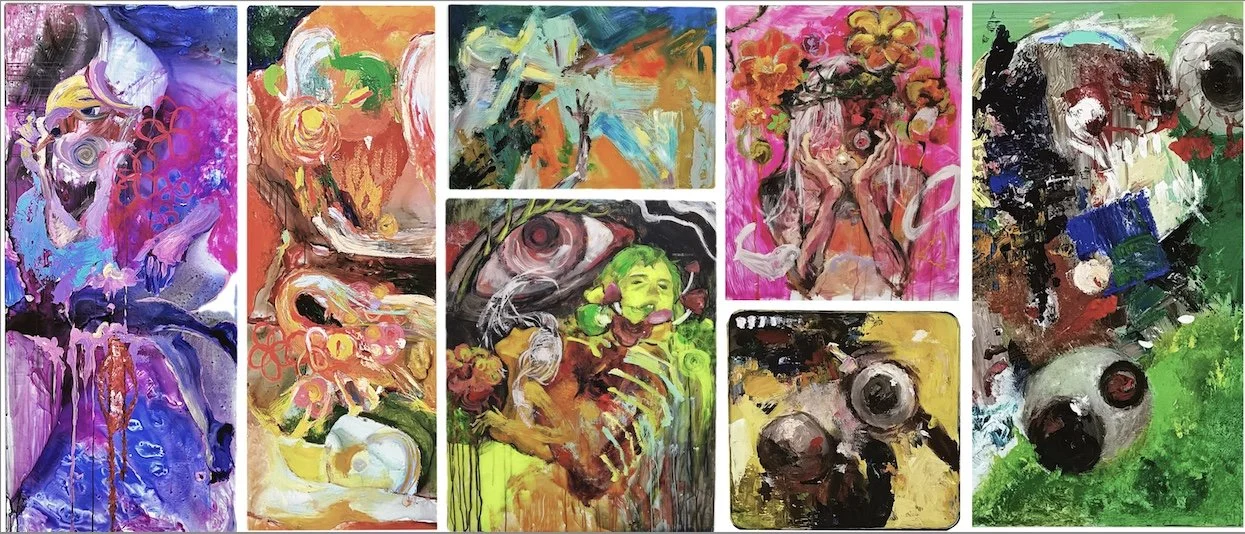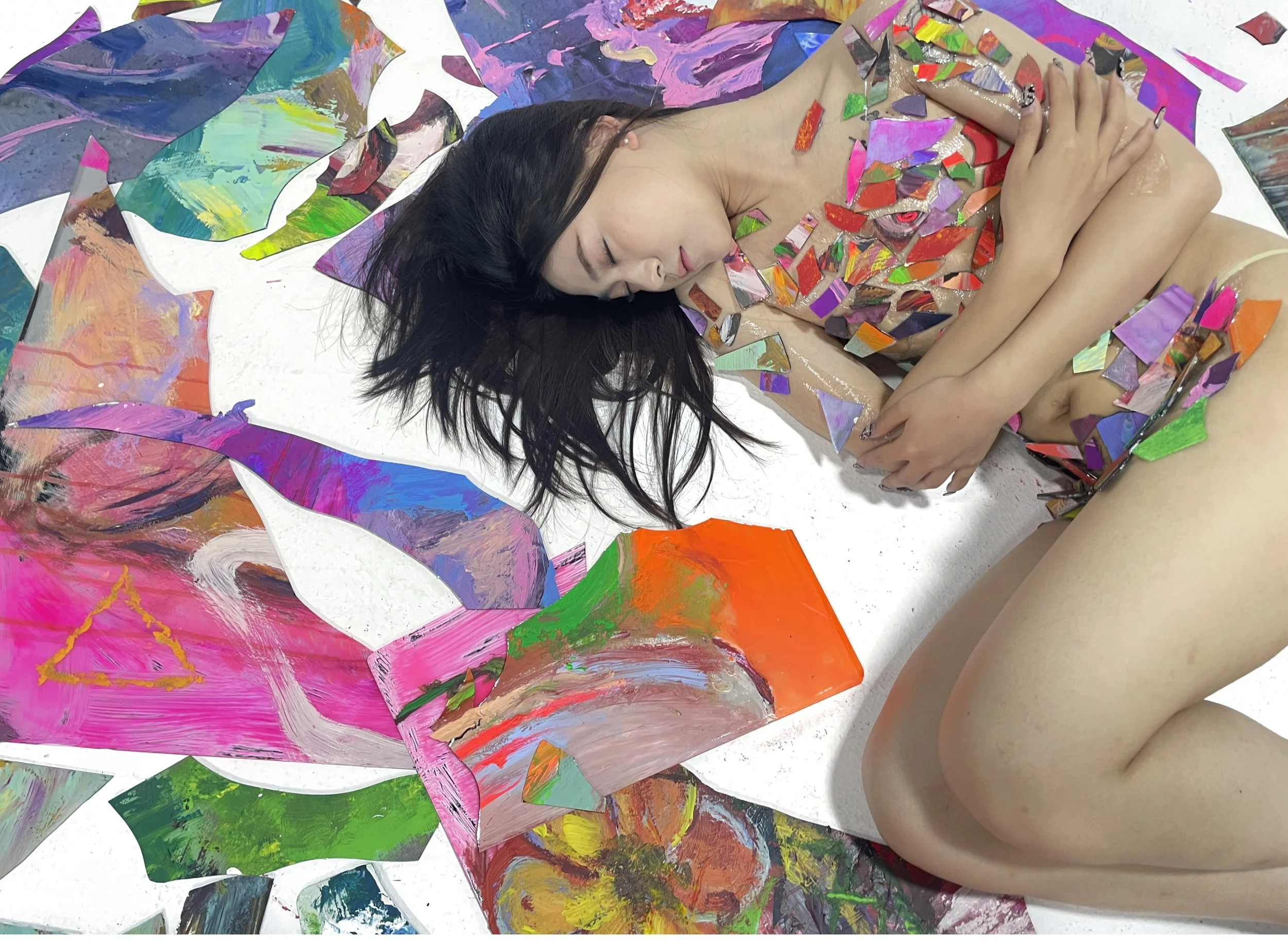
tianjin yu
虞添锦(Tina),毕业于重庆西南大学油画专业,其创作始终围绕人类存在本质与精神内核展开。她深谙油画专业打下的扎实功底,更善于突破媒介边界——既从多元视角探索人体规律,又在实践中融合绘画、行为艺术、装置艺术等多种形式,形成独特的创作语言。
此次深造,她旨在进一步拓宽艺术视野:探索更多元的创作形式,沉浸体验不同地域的人文风俗,最终为自身艺术实践发掘更多可能性。
Tianjin Yu(Tina), a graduate of Southwest University in Chongqing with a major in oil painting and current Masters of Fine Arts student at the Glasgow School of Art, centres her creative practice on exploring the essence of human existence and the spiritual core of life. With a strong foundation in traditional oil painting, she excels at breaking the boundaries of medium — exploring the human form from multiple perspectives while integrating painting, performance, and installation art into a unique artistic language.
Through her current studies, she aims to further broaden her artistic vision by exploring more diverse creative forms and immersing herself in different cultures and traditions, ultimately discovering new possibilities for her artistic practice.
recipe
食谱
番茄炒蛋
scrambled eggs with tomatoes
Title of final work needed
Oil painting on mirrors; 2 x 0.8m; 1.65 x 0.6m; 0.8 x 1m; 0.8 x 1m; 0.6 x 0.8 m; 0.5 x 0.7 m; 0.5 x 0.5m
添锦成长在一个典型的中国式家庭,父亲在外工作,母亲承担了几乎所有的家庭事务。后来母亲重返职场,却依然要同时兼顾家庭与事业。添锦从母亲身上看到了女性的坚韧与包容,也意识到社会对女性角色的隐形期待。这些经历深深影响了她的创作视角,使她的作品始终带有鲜明的女性意识。
在她的作品中,她以镜子为媒介,探讨“少女情绪”与“社会规训”的主题。作品灵感来自社会学家库利提出的“镜中之我”理论——人们通过他人的眼光来认识自己。她将七种不同的情绪绘制在镜子上,再将镜子打碎,最后把碎片贴回到少女的身体上。镜子象征外界的目光与评判,而碎裂与重组的过程,则代表着女性在破碎与重塑中重新找回自我。
添锦认为,这是一种“重生”的象征——当女性打破外界的规训,把评判的标准重新归还给自己,便是自我重生的开始。
她的作品与我们展览的主题“家庭作为档案 / 母亲、祖母、女儿作为档案”高度契合。通过母亲的形象与个人创作的结合,添锦让家庭经验与女性记忆成为了活生生的档案,记录着情感的传承与自我觉醒的力量。
Yu grew up in a traditional Chinese family where her father worked outside and her mother took care of almost everything at home. Later, when her mother returned to work, she still had to carry the double burden of both career and family. Through observing her mother’s resilience, Yu developed a strong awareness of women’s strength and the invisible social expectations placed on them. This female perspective has deeply influenced her artistic practice.
In her work, Yu explores female emotions and social discipline through a very unique medium — mirror. Inspired by Cooley’s concept of the “Looking Glass Self,” she painted seven different emotions on mirrors, shattered them, and then reattached the fragments onto a girl’s body. The mirrors symbolize how women are constantly reflected and judged by others, while the act of breaking and reassembling represents reclaiming one’s self-image and emotional integrity.
Yu described this process as a metaphor for female self-examination and rebirth — breaking the external expectations and re-owning the fragmented parts of the self.
Through her mother’s story and her own creative reflection, Yu’s work becomes a living archive of female experience. It records the inheritance of emotions and the power of self-awakening.
Title of the work needed
食材清单:
鸡蛋两个
西红柿两个
葱
大蒜
做法步骤
1番茄切成一口大小,小葱切成段,大蒜切末,蛋液中加少许盐搅匀备用。
2热油锅放入蒜末炒香,加入番茄快炒,以盐1/3小勺、胡椒调味。
3将蛋液打入锅中,以大火炒至蛋半熟时加入葱段,略炒后起锅。
Ingredients:
2 eggs
2 tomatoes
Scallions
Garlic
Cooking steps:
1. Cut the tomatoes into bite-sized pieces. Chop the scallions into sections and mince the garlic. Add a pinch of salt to the beaten eggs and stir well for later use.
2. Heat oil in a pan, add the minced garlic and sauté until fragrant. Add the tomatoes and stir-fry quickly. Season with 1/3 teaspoon of salt and some pepper.
3. Pour the egg mixture into the pan. Stir-fry over high heat until the eggs are half-cooked, then add the scallion sections. Stir-fry briefly and then serve.
song
歌
小海螺
small conch
歌词:
小海螺呀小海螺,歌儿唱的多快乐,海螺海螺唱的是什么?
竖起我的小耳朵,听呀听一听,哗哗哗哗哗哗,噢!唱的是那大海的歌。
小海螺呀小海螺,你是我的好朋友,跟我唱歌多呀多快乐,歌声飞出心窝窝,飞出心窝窝,哗哗哗哗哗哗,嘿!唱不完那大海的歌。
Lyrics:
Little conch, little conch, how happy you are singing. What are you singing, conch?
Prick up my little ears and listen. Hush, hush, hush, hush. Oh! It's the song of the sea.
Little conch, little conch, you are my good friend. How happy we are singing together. The song flies out of my heart, out of my heart. Hush, hush, hush, hush. Hey! The song of the sea can never be finished.






